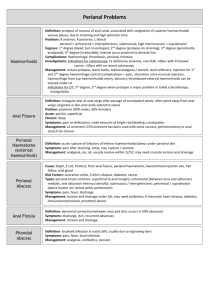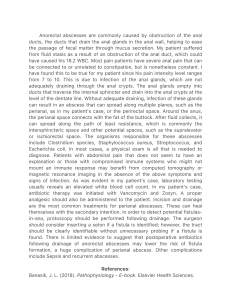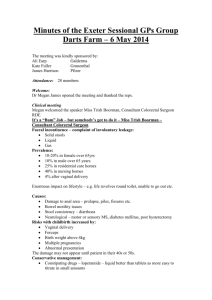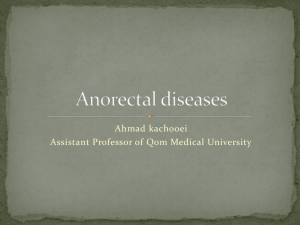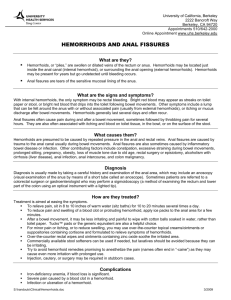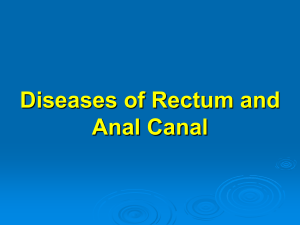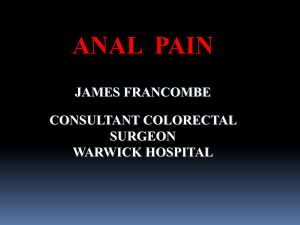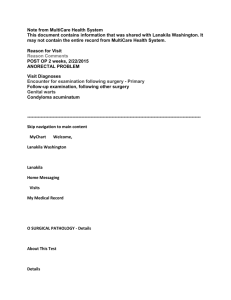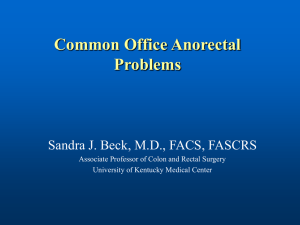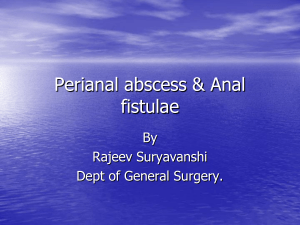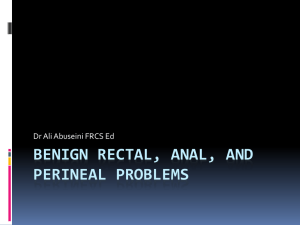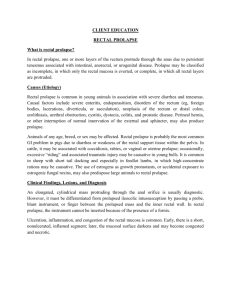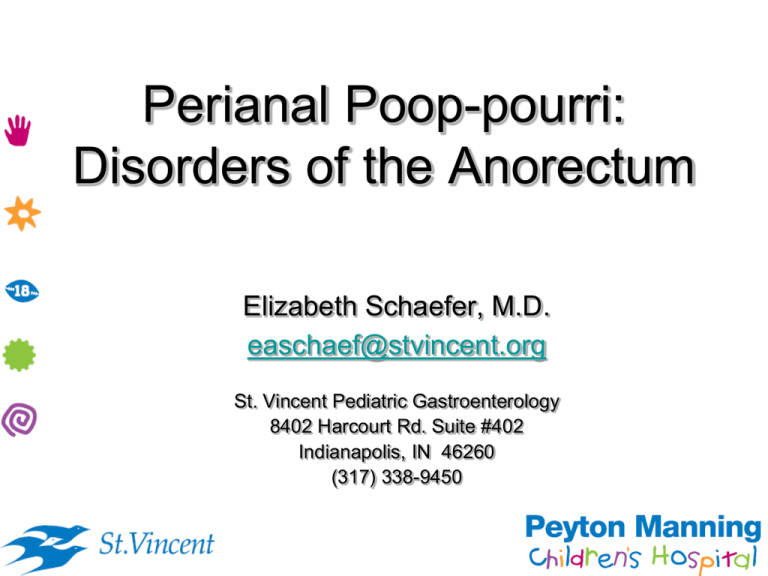
Perianal Poop-pourri:
Disorders of the Anorectum
Elizabeth Schaefer, M.D.
easchaef@stvincent.org
St. Vincent Pediatric Gastroenterology
8402 Harcourt Rd. Suite #402
Indianapolis, IN 46260
(317) 338-9450
Objectives
• Review clinical presentations of classic
perianal disorders
• Make the diagnosis
• Review the management and identify
when and who to consult
Is this normal?
• Document anal opening not in
the center of the perineal
pigmented area
• API (Anal Position Index):
– Normal: halfway between coccyx
and introitus or scrotum
– Female: anus-fourchette/coccyxfourchette 0.45+/- 0.08
– Male: anus-scrotum/coccyxscrotum 0.54 +/- 0.07
• 4% of infants
• Refer to surgery if severe
constipation associated with
API <2SD from the mean
– <0.29 in girls, <0.40 in boys
What does this “bucket handle”
bridge represent?
• Rectum passes through the
levator ani
• Fistulous tract extends to
perineal region
• Prognosis favorable for low
lesions because they lie within
the levator ani complex
Rectal Fissure
• Superficial tears of anoderm,
inferior to the dentate line
• 90% posterior
• Due to constipation, although
history only elicited in 25% of
cases
• Presentation: pain, bleeding
• Diagnosis:
– acute fissures are typically small
– chronic fissures assoc w/ skin tag
or fibrosis
– Remember if fissure is large or
there is bruising, consider abuse
Rectal Fissure
• Management
– Decrease trauma
• Stool softeners
• Lubricant laxative
• Fiber
– Reduce anal
sphincter tone
• Warm sitz baths
– Good hygiene
– >80% heal
• Chronic fissures
– >6 weeks
– Uncommon in kids
– Dilation to reduce
anal spasm
– Nitric oxide (0.2%
glycerol trinitrate)
– Botulism toxin
– Surgery:
• lateral internal
sphincterotomy
Perianal Strep
• Presentation
–
–
–
–
–
Well demarcated rash
6 mo – 10 yrs old
Cellulitis in 90%, pruritis in 80%
Pain, pruritis, bleeding
Familial spread possible
• Diagnosis:
– Group A B-hemolytic
streptococcal infections found on
perianal cx
• Treatment:
– 10 days of oral penicillin
– EES for PCN allergic patient
– Clindamycin +/- mupirocin
• 40-50% recurrence rate
Chronic Pruritis Ani
• Enterobius
vermicularis
• Presentation: anal
pruritis
• Dead parasites and
eggs in the perianal
area may also cause
abscesses and
granulomas
Perianal Fistula
• Chronic track of granulation
tissue connecting two
epithelial lined surfaces
• Most fistulas originate below
the dentate line
• A fistulous abscess becomes
a fistula when it ruptures
• Surgical drainage
– Except in known or suspected
Crohn’s disease
• Pack the cavity or catheter to
drain
• Sitz or tub baths, analgesics
• Antibiotics
Perianal Fistula
• The internal opening
in children is on the
pectinate line
radially opposite the
external orifice
• Unroof the fistula
• Keep area clean
with soap and water
Infliximab in Patients with
Fistulizing Crohn’s Disease
Perianal Fistula Case Study
Pretreatment
2 Weeks
10 Weeks
18 weeks
Present D, et al. NEJM. 1999; 340:1398-405.
Perirectal Abscess
• Majority result from a crypt of Morgagni infection
• Classification determined by anatomic location of lesion
relative to the levator ani and sphincteric muscles
Perirectal Abscesses
• Management
• Presentation
– Males > Females
– 98% report persistent
perirectal pain
– Abscesses identified
in 95% of cases
when an external
perianal exam in
combined with a
digital rectal exam
– Sitz baths
– Antibiotics
– Surgical options:
• If chronic fistulae beyond 3
months despite medical
management
• Fistulectomy
• Fistulotomy
• Seton loop
– Consider evaluation for
neutropenia, leukemia,
HIV, diabetes, IBD
Rectal Prolapse
• Mucosal vs full thickness
• Males > Females
• Etiologies:
–
–
–
–
Constipation
Diarrhea
Cystic fibrosis
Other: intra-abdominal pressure,
polyps, parasites, malnutrition,
pelvic floor weakness
• Usually self limited
• If recurrent and pronounced
– Sweat chloride
– Screen for parasites
Rectal Prolapse
• Treatment: Manual reduction, treat primary inciting factor
• If persistent: surgical – injection of sclerosant or hypertonic saline
submucosally or submuscularly above dentate line
• Prognosis generally good
Hemorrhoids
• Small asymptomatic: not
uncommon
• Symptomatic:
– Due to chronic straining
– Anal infection spreading to
hemorrhoidal veins
– Underlying Crohn’s disease
• Male = Female
• Presentation: Bleeding,
pruritis, prolapse, pain
• Diagnosis: Clinical history
and careful exam
Hemorrhoids
• External Hemorrhoids
– From ectoderm and arise distal
to dentate line
– Stratified squamous epithelium
– Inferior rectal nerve - painful
• Internal Hemorrhoids
– Above the dentate line from
embryonic endoderm
– Simple columnar epithelium
– Painless
– Classified by the degree of
prolapse
– Pathogenesis: ?
•
•
•
•
Low fiber diets
Decreased venous return
Prolonged sitting on toilet
aging
Hemorrhoids: Treatment
• Conservative Options
– Indication: Grade I & II internal;
non-thrombosed external
– Sitz baths bid-tid
– High-fiber diet
– Fluid intake
– Stool softeners
– Topical/systemic analgesic
– Proper anal hygiene
– Short term topical steroid
(hydrocortisone acetate 2.5%
and pramoxine HCL1% cream)
• Non-surgical Options
– Indication: Recalcitrant
hemorrhoids
– Rubber band ligation*
– Infrared coagulation*
– Injection sclerotherapy
– Laser therapy
– Cryosurgery
• Surgical Management
– Nonsurgical treatment failure
– Grade III & IV internal with
severe symptoms
– 5-10% eventually require
surgery
– Hemorrhoidectomy
More is not necessarily better
References
•
•
•
•
•
•
Browning J, Levy M. Cellulitis and Superficial Skin Infections. In: Long SS, Pickering LK, Prober
CG, ed. Principles and Practice of Pediatric Infectious Diseases. 3rd ed. Hamilton, Ontario:
Churchill Livingstone; 2008. Chapter 72.
Davari HA. The anal position index: a simple method to define the normal position of the anus in
neonate. Acta Paediatr. 2006;95:877
Gourgiotis S, Baratsis S. Rectal prolapse. Int J Colorectal Dis. 2007;22:231-243
Langer M, Modi BP: Benign Perianal Lesions. In Kleinman RE, Goulet O, et al, eds. Pediatric
Gastrointestinal Disease. 5th ed. Hamilton, Ontario: BC Decker Inc; 2008” 368-369.
Pfefferkorn M, Fitzgerald J. Disorders of the Anorectum: fissures, fistulae, prolapse, hemorrhoids,
tags. In: Wyllie R, Hyams JS, eds. Pediatric Gastrointestinal and Liver Disease, 3rd ed., 2006;
801-807.
Walker W, et al, eds. Pediatric Gastrointestinal Disease. 4th ed. Hamilton, Ontario: BC Decker,
2004: Chapter 35

